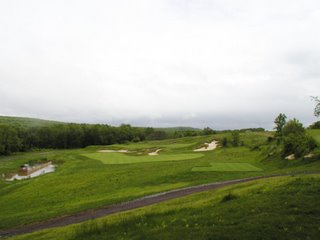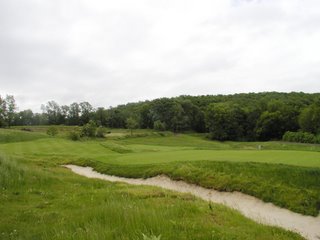More Great Holes - the 13th at The Golf Club

The low timber wall and marsh very much in play from the tee at The Golf Club.
In modern times there is no greater influence on the latest crop of designers than Pete Dye. Not only has he helped personally shape the thinking of the two top designers in the game right now, he has also had at least some influence on all the designers of his generation. His attempt to change golf architecture worked, initially ushering in style that dominated the 80’s and 90’s, and later on ushering in the new school of “minimalism” as more people caught on to The Golf Club and Crooked Stick.
There is no question in my mind that Pete Dye’s work in the 1960’s and 1970’s was far more revolutionary and important than the work he is better known for. I have talked at length about The Golf Club being one of my influences and an inspiration to many of the current architects leading a new trend. I also think it showcases much of his architectural thinking and his strong use of strategy to make a great golf course. The Golf Club initially blew me away with its look and feel, it took longer to recognize the underlying strategies of holes like 6 and 7. The fact that it was done right in the middle of everything Trent Jones is really fun historically. The hole that caught my attention the most was the 13th. At 370 yards, it was relatively short, but what an interesting hole to play. Pete Dye took uninspiring section of land and created first a marshland and then a pond to influence play. This also impacted the look and feel of the hole too. Dye says he was influenced by Prestwick when he created this course, but truth be told it is 100% Pete Dye. The marsh is a wonderful natural looking feature that gives the hole a soft edge; he then accentuated this with a hard defined edge using a low timber wall to define the carry line. The blue line on the plan locates the low wall, the red line shows the effective carry angle, the yellow the logical lines in to the green. The player stands upon the tee and has the opportunity to play short, but because of the obvious carry line is drawn into risking a carry over the corner of the marsh to shorten the hole. If successful, the next shot in is a beauty with the pond on the left, the fantastically clever timber edged waste on the right and the pond in behind the green. Of course the front is wide open, since the flanking hazards are the ones that the best players have the most trouble with and the weaker players are left with a safe route in. This is a classic set of strategies within a very natural setting - which was 100% created by Pete!
The Golf Club initially blew me away with its look and feel, it took longer to recognize the underlying strategies of holes like 6 and 7. The fact that it was done right in the middle of everything Trent Jones is really fun historically. The hole that caught my attention the most was the 13th. At 370 yards, it was relatively short, but what an interesting hole to play. Pete Dye took uninspiring section of land and created first a marshland and then a pond to influence play. This also impacted the look and feel of the hole too. Dye says he was influenced by Prestwick when he created this course, but truth be told it is 100% Pete Dye. The marsh is a wonderful natural looking feature that gives the hole a soft edge; he then accentuated this with a hard defined edge using a low timber wall to define the carry line. The blue line on the plan locates the low wall, the red line shows the effective carry angle, the yellow the logical lines in to the green. The player stands upon the tee and has the opportunity to play short, but because of the obvious carry line is drawn into risking a carry over the corner of the marsh to shorten the hole. If successful, the next shot in is a beauty with the pond on the left, the fantastically clever timber edged waste on the right and the pond in behind the green. Of course the front is wide open, since the flanking hazards are the ones that the best players have the most trouble with and the weaker players are left with a safe route in. This is a classic set of strategies within a very natural setting - which was 100% created by Pete!






